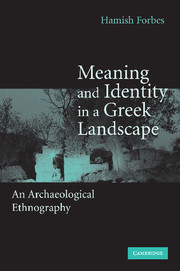Book contents
- Frontmatter
- Contents
- List of Illustrations and Tables
- Preface and Acknowledgements
- Transliteration Conventions
- 1 Introduction
- 2 Landscape Studies: From Frame-and-Tame to Visceral Feeling
- 3 Historical Background to the Landscape of Methana
- 4 Conducting Fieldwork on Methana
- 5 Kinship, Marriage and the Transmission of Names and Property
- 6 The Productive Landscape
- 7 The Historical Landscape: Memory, Monumentality and Time-Depth
- 8 The Kinship Landscape
- 9 The Religious Landscape
- 10 Conclusions: A Greek Landscape from Within
- Glossary
- Notes
- References
- Index
3 - Historical Background to the Landscape of Methana
Published online by Cambridge University Press: 04 May 2010
- Frontmatter
- Contents
- List of Illustrations and Tables
- Preface and Acknowledgements
- Transliteration Conventions
- 1 Introduction
- 2 Landscape Studies: From Frame-and-Tame to Visceral Feeling
- 3 Historical Background to the Landscape of Methana
- 4 Conducting Fieldwork on Methana
- 5 Kinship, Marriage and the Transmission of Names and Property
- 6 The Productive Landscape
- 7 The Historical Landscape: Memory, Monumentality and Time-Depth
- 8 The Kinship Landscape
- 9 The Religious Landscape
- 10 Conclusions: A Greek Landscape from Within
- Glossary
- Notes
- References
- Index
Summary
[Barba Andreas] said that before the 1821 war Methana was deserted: so were Aegina and other places. Only after that period was Methana settled. The people who had previously been on Methana had fled at the coming of the Turks.
(Entry in field notes)This chapter presents the chronological background to later sections of this work. Part of its remit is to discuss the origins of important features which appear in later chapters. The issues explored include the origins of Methanites and their villages, the origins of the agrarian landscape, and the changing local economy. Although the subject matter of this book tends to focus discussion within the confines of the peninsula in terms of how Methanites view their peninsular landscapes, this chapter demonstrates that over hundreds of years, what might be seen as purely local developments have been powerfully influenced by external factors.
The balance between internal and external factors is also played out at a dialectical level in apparent contradictions between documentary and oral sources on some of these significant historical developments. The former are represented partly by brief but informative accounts of the peninsula given by western European travellers who visited in the eighteenth and earlier nineteenth centuries. Archaeological data, which provide a great deal of historical evidence especially for the earlier periods discussed, also fall firmly under the heading of documentary sources. Significantly, most of the archaeological work on the peninsula has also been conducted by non-Greeks (Deffner 1909; Mee and Forbes [eds.] 1997; Vanderpool 1930).
- Type
- Chapter
- Information
- Meaning and Identity in a Greek LandscapeAn Archaeological Ethnography, pp. 50 - 96Publisher: Cambridge University PressPrint publication year: 2007



